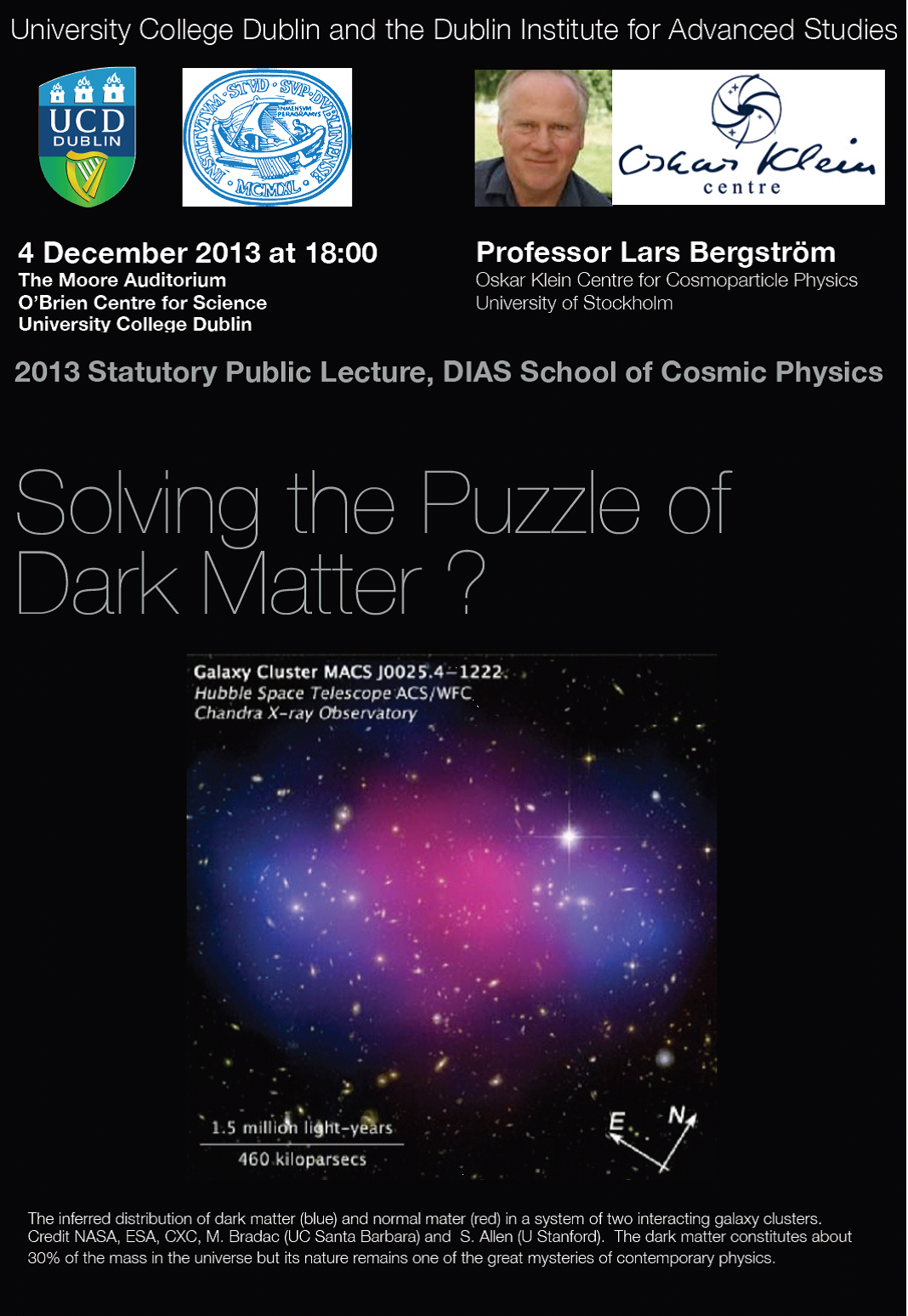School of Cosmic Physics Statutory Public Lecture 2013 – Wednesday 4th December
“Solving the Puzzle of Dark Matter?” by Professor Lars Bergström, Professor of Theoretical Physics, Stockholm University and Secretary of the Nobel Committee for Physics.
Wednesday 4th December at 6:00pm. Moore Auditorium, O’Brien Centre for Science (Science Centre East), UCD, Dublin 4. Admission is free.
Location: Building No. 67 on http://www.ucd.ie/maps/2013/UCD_Map_August_2013.pdf
The Moore Auditorium is located on the ground floor (right-hand side) of the new UCD O’Brien Centre for Science (Science Centre East).
Abstract:
Cosmologists are becoming ever more certain that a large fraction of the mass in the universe is invisible and does not emit or absorb light. This talk will give a basic introduction to the history and status of the dark matter problem, and discuss three different methods to find out what it is. First, the LHC accelerator will have a real chance of discovering dark matter particles, if the mass scale is not too high. Second, direct search for scattering of dark matter particles in underground detectors is reaching a sensitivity where a signal may soon be found. The third method, which is useful even if the dark matter particle would have a very high mass, uses indirect detection through annihilation of dark matter particles in our galaxy to gamma-rays, neutrinos or antimatter. All three methods have now reached a sensitivity that a dark matter signal may be soon be found. However, this also means that one has to be aware of false claims of discovery. A summary of the current, somewhat confusing, experimental situation will be presented.

Leave a Comment
Last Updated: 23rd May 2018 by mary
School of Cosmic Physics Statutory Public Lecture 2013 – Wednesday 4th December
School of Cosmic Physics Statutory Public Lecture 2013 – Wednesday 4th December
“Solving the Puzzle of Dark Matter?” by Professor Lars Bergström, Professor of Theoretical Physics, Stockholm University and Secretary of the Nobel Committee for Physics.
Wednesday 4th December at 6:00pm. Moore Auditorium, O’Brien Centre for Science (Science Centre East), UCD, Dublin 4. Admission is free.
Location: Building No. 67 on http://www.ucd.ie/maps/2013/UCD_Map_August_2013.pdf
The Moore Auditorium is located on the ground floor (right-hand side) of the new UCD O’Brien Centre for Science (Science Centre East).
Abstract:
Cosmologists are becoming ever more certain that a large fraction of the mass in the universe is invisible and does not emit or absorb light. This talk will give a basic introduction to the history and status of the dark matter problem, and discuss three different methods to find out what it is. First, the LHC accelerator will have a real chance of discovering dark matter particles, if the mass scale is not too high. Second, direct search for scattering of dark matter particles in underground detectors is reaching a sensitivity where a signal may soon be found. The third method, which is useful even if the dark matter particle would have a very high mass, uses indirect detection through annihilation of dark matter particles in our galaxy to gamma-rays, neutrinos or antimatter. All three methods have now reached a sensitivity that a dark matter signal may be soon be found. However, this also means that one has to be aware of false claims of discovery. A summary of the current, somewhat confusing, experimental situation will be presented.
Category: News
Recent Posts
DIAS Astrophotography competition goes mobile for 2024
Irish scientists are part of groundbreaking discovery with James Webb Space Telescope
Dr Pauline Gagnon (formerly of CERN) to deliver two talks at DIAS
DIAS Professor announced as next President of the European Southern Observatory’s Council
Quake Shake: New programme encourages people to get involved in monitoring earthquakes
Language switcher